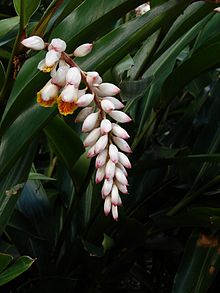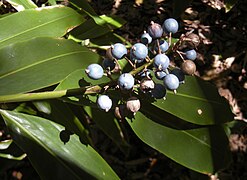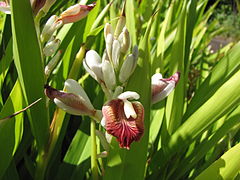Alpinia
| Alpinia | |
|---|---|

| |
| Alpinia zerumbet | |
| Scientific classification | |
| Kingdom: | Plantae |
| Clade: | Tracheophytes |
| Clade: | Angiosperms |
| Clade: | Monocots |
| Clade: | Commelinids |
| Order: | Zingiberales |
| Family: | Zingiberaceae |
| Subfamily: | Alpinioideae |
| Tribe: | Alpinieae |
| Genus: | Alpinia Roxb.,1810 |
| Species | |
|
See text | |
| Synonyms[1] | |
|
20 synonyms
| |
Alpiniais agenusofflowering plantsin the ginger family,Zingiberaceae.Species are native to Asia, Australia, and the Pacific Islands, where they occur intropicalandsubtropicalclimates.[2]Several species are cultivated asornamental plants.[3]
Taxonomy
[edit]The genus was erected by the Scottish botanistWilliam Roxburghin 1810, and published in the journal Asiatic Researches[4]It is named afterProspero Alpini,a 17th-century Italian botanist who specialized in exotic plants.[5]Species of the genus are known generally asshell gingers.[3][6]
-
Alpinia hainanensis'Shengzhen'
-
Alpinia hainanensis'Shengzhen'
Description
[edit]These herbs lack true stems, but have pseudostems usually up to about 3 metres (9.8 ft) long which are composed of the overlapping leaf sheaths.[2][3]A few species have been known to reach 8 metres (26 ft).[7]They grow from thickrhizomes.The leaves are lance-shaped to oblong. Theinflorescencetakes the form of a spike, apanicle,or araceme.It may be hooded inbractsand bracteoles. The flower has a shallowly toothedcalyxwhich is sometimes split on one side. The flower corolla is a cylindrical tube with three lobes at the mouth, the middle lobe larger and hoodlike in some taxa. There is one fertilestamenand twostaminodes,which are often joined into a petal-likelabellum,a structure that is inconspicuous in some species and quite showy in others. The fruit is a rounded, dry or fleshy capsule.[2][3]The plants are generally aromatic due to theiressential oils.[8]
Species
[edit]This is the largest genus in the ginger family,[7]with 248 species and 2 hybrids accepted byPlants of the World Onlineas of 27 June 2024[update].[1]A number of those are commonly grown for their flowers, includingred ginger,and others are used as spices, includingGalangal.
Accepted species
[edit]- Alpinia abundifloraBurtt & R.M.Sm.
- Alpinia acuminataR.M.Sm.
- Alpinia adanaC.K.Lim
- Alpinia aeneaB.L.Burtt & R.M.Sm.
- Alpinia albipurpurea(P.Royen) R.M.Sm.
- Alpinia amentaceaR.M.Sm.
- Alpinia apoensisElmer
- Alpinia aquatica(Retz.) Roscoe
- Alpinia arctiflora(F.Muell.) Benth.
- Alpinia arfakensisK.Schum.
- Alpinia argentea(B.L.Burtt & R.M.Sm.) R.M.Sm.
- Alpinia arundelliana(F.M.Bailey) K.Schum.
- Alpinia asmyC.K.Lim
- Alpinia assimilisRidl.
- Alpinia athroanthaValeton
- Alpinia austrosinense(D.Fang) P.Zou & Y.S.Ye
- Alpinia bambusifoliaC.F.Liang & D.Fang
- Alpinia beamaniiR.M.Sm.
- Alpinia biakensisR.M.Sm.
- Alpinia bodeniiR.M.Sm.
- Alpinia boiaSeem.
- Alpinia boninsimensisMakino
- Alpinia borraginoidesK.Schum.
- Alpinia brachyanthaMerr.
- Alpinia brevilabrisC.Presl
- Alpinia breviligulata(Gagnep.) Gagnep.
- Alpinia brevisT.L.Wu & S.J.Chen
- Alpinia caerulea(R.Br.) Benth.
- Alpinia calcarata(Andrews) Roscoe
- Alpinia calcicolaQ.B.Nguyen & M.F.Newman
- Alpinia calycodesK.Schum.
- Alpinia capitellataJack
- Alpinia carinataValeton
- Alpinia carolinensisKoidz.
- Alpinia celebicaK.Schum.
- Alpinia chaunocoleaK.Schum.
- Alpinia chinensis(Retz.) Roscoe
- Alpinia chrysorachisK.Schum.
- Alpinia coeruleoviridisK.Schum.
- Alpinia conchigeraGriff.
- Alpinia condensataValeton
- Alpinia confertaB.L.Burtt & R.M.Sm.
- Alpinia congestaElmer
- Alpinia conghuaensisJ.P.Liao & T.L.Wu
- Alpinia conglomerataR.M.Sm.
- Alpinia copelandiiRidl.
- Alpinia coriaceaT.L.Wu & S.J.Chen
- Alpinia coriandriodoraD.Fang
- Alpinia corneri(Holttum) R.M.Sm.
- Alpinia cumingiiK.Schum.
- Alpinia cylindrocephalaK.Schum.
- Alpinia dasystachysValeton
- Alpinia dekockiiValeton
- Alpinia densibracteataT.L.Wu & S.J.Chen
- Alpinia densifloraK.Schum.
- Alpinia denticulata(Ridl.) Holttum
- Alpinia diffissaRoscoe
- Alpinia divaricataValeton
- Alpinia diversifolia(Elmer) Elmer
- Alpinia domatiferaValeton
- Alpinia elegans(C.Presl) K.Schum.
- Alpinia elmeriR.M.Sm.
- Alpinia emaculataS.Q.Tong
- Alpinia epiphyticaMeekiong, Ipor & Tawan
- Alpinia eremochlamysK.Schum.
- Alpinia euastraK.Schum.
- Alpinia eubracteaK.Schum.
- Alpinia faxB.L.Burtt & R.M.Sm.
- Alpinia flabellataRidl.
- Alpinia flagellaris(Ridl.) Loes.
- Alpinia formosanaK.Schum.
- Alpinia foxworthyiRidl.
- Alpinia fusiformisR.M.Sm.
- Alpinia gagnepainiiK.Schum.
- Alpinia galanga(L.) Willd.
- Alpinia giganteaBlume
- Alpinia glabraRidl.
- Alpinia glabrescensRidl.
- Alpinia glacicaeruleaR.M.Sm.
- Alpinia globosa(Lour.) Horan.
- Alpinia gracillimaValeton
- Alpinia gramineaRidl.
- Alpinia guinanensisD.Fang & X.X.Chen
- Alpinia haenkeiC.Presl
- Alpinia hagenaR.M.Sm.
- Alpinia hainanensisK.Schum.
- Alpinia hanseniiR.M.Sm.
- Alpinia havilandiiK.Schum.
- Alpinia hibinoiMasam.
- Alpinia himantoglossaRidl.
- Alpinia hirsuta(Lour.) Horan.
- Alpinia hoangvietD.D.Nguyen & V.C.Nguyen
- Alpinia hongiaoensisTagane
- Alpinia horneanaK.Schum.
- Alpinia hulstijniiValeton
- Alpinia hylandiiR.M.Sm.
- Alpinia illustrisRidl.
- Alpinia inaequalis(Ridl.) Loes.
- Alpinia intermediaGagnep.
- Alpinia janowskiiValeton
- Alpinia japonica(Thunb.) Miq.
- Alpinia javanicaBlume
- Alpinia gian ganfengT.L.Wu
- Alpinia jingxiensisD.Fang
- Alpinia juliformis(Ridl.) R.M.Sm.
- Alpinia kawakamiiHayata
- Alpinia kiungensisR.M.Sm.
- Alpinia klossii(Ridl.) R.M.Sm.
- Alpinia koidzumianaKitam.
- Alpinia koshunensisHayata
- Alpinia kusshakuensisHayata
- Alpinia kwangsiensisT.L.Wu & S.J.Chen
- Alpinia lalashanensisS.S.Ying
- Alpinia laosensisGagnep.
- Alpinia latilabrisRidl.
- Alpinia lauterbachiiValeton
- Alpinia laxisecundaB.L.Burtt & R.M.Sm.
- Alpinia leptostachyaValeton
- Alpinia ligulataK.Schum.
- Alpinia ludwigianaR.M.Sm.
- Alpinia maclureiMerr.
- Alpinia macrocephalaK.Schum.
- Alpinia macrocristaArdiyani & Ardi
- Alpinia macroscaphisK.Schum.
- Alpinia macrostaminodiaChaveer. & Sudmoon
- Alpinia macrostephana(Baker) Ridl.
- Alpinia macrouraK.Schum.
- Alpinia malaccensis(Burm.f.) Roscoe
- Alpinia maniiBaker
- Alpinia manostachysValeton
- Alpinia martiniR.M.Sm.
- Alpinia maxiiR.M.Sm.
- Alpinia melichroaK.Schum.
- Alpinia menghaiensisS.Q.Tong & Y.M.Xia
- Alpinia mesantheraHayata
- Alpinia microlophonRidl.
- Alpinia modestaF.Muell. ex K.Schum.
- Alpinia mollisC.Presl
- Alpinia mollissimaRidl.
- Alpinia monopleuraK.Schum.
- Alpinia multispica(Ridl.) Loes.
- Alpinia murdochiiRidl.
- Alpinia musifoliaRidl.
- Alpinia muticaRoxb.
- Alpinia myriocrateraK.Schum.
- Alpinia nantoensisF.Y.Lu & Y.W.Kuo
- Alpinia napoensisH.Dong & G.J.Xu
- Alpinia nelumboidesNob.Tanaka, T.T.K.Van & V.Hoang
- Alpinia newmaniiN.S.Lý
- Alpinia nidus-vespaeA.Raynal & J.Raynal
- Alpinia nieuwenhuiziiValeton
- Alpinia nigra(Gaertn.) Burtt
- Alpinia nobilisRidl.
- Alpinia novae-hiberniaeB.L.Burtt & R.M.Sm.
- Alpinia novae-pommeraniaeK.Schum.
- Alpinia nutans(L.) Roscoe
- Alpinia oblongifoliaHayata
- Alpinia odontonemaK.Schum.
- Alpinia officinarumHance
- Alpinia oliganthaValeton
- Alpinia orientalisDocot & Banag
- Alpinia orthostachysK.Schum.
- Alpinia ouiY.H.Tseng & Chih C.Wang
- Alpinia ovataZ.L.Zhao & L.S.Xu
- Alpinia ovoidocarpaH.Dong & G.J.Xu
- Alpinia oxymitraK.Schum.
- Alpinia oxyphyllaMiq.
- Alpinia padacancaValeton ex K.Heyne
- Alpinia pahangensisRidl.
- Alpinia papuanaScheff.
- Alpinia parksii(Gillespie) A.C.Sm.
- Alpinia pendulifloraRidl.
- Alpinia petiolataBaker
- Alpinia pinnanensisT.L.Wu & S.J.Chen
- Alpinia platychilusK.Schum.
- Alpinia platylopha(Ridl.) Loes.
- Alpinia polyanthaD.Fang
- Alpinia porphyreaR.M.Sm.
- Alpinia porphyrocarpaRidl.
- Alpinia priceiHayata
- Alpinia psilogynaD.Fang
- Alpinia ptychantheraK.Schum.
- Alpinia pubiflora(Benth.) K.Schum.
- Alpinia pulchella(K.Schum.) K.Schum.
- Alpinia pulcherrimaRidl.
- Alpinia pulchra(Warb.) K.Schum.
- Alpinia pumilaHook.f.
- Alpinia purpurata(Vieill.) K.Schum.
- Alpinia pusillaArdi & Ardiyani
- Alpinia rafflesianaWall. ex Baker
- Alpinia regiaK.Heyne ex R.M.Sm.
- Alpinia rigidaRidl.
- Alpinia romblonensisElmer
- Alpinia romburghianaValeton
- Alpinia rosaceaValeton
- Alpinia roseaElmer
- Alpinia roxburghiiSweet
- Alpinia rubricaulisK.Schum.
- Alpinia rubromaculataS.Q.Tong
- Alpinia rufa(C.Presl) Náves
- Alpinia rufescens(Thwaites) K.Schum.
- Alpinia rugosaS.J.Chen & Z.Y.Chen
- Alpinia salomonensisB.L.Burtt & R.M.Sm.
- Alpinia samoensisReinecke
- Alpinia sandsiiR.M.Sm.
- Alpinia scabra(Blume) Náves
- Alpinia schultzeiLauterb. ex Valeton
- Alpinia seimundiiRidl.
- Alpinia sericifloraK.Schum.
- Alpinia sessilifloraKitam.
- Alpinia shimadaeHayata
- Alpinia shoukaensisS.S.Ying
- Alpinia siamensisK.Schum.
- Alpinia sibuyanensisElmer
- Alpinia singulifloraR.M.Sm.
- Alpinia smithiaeM.Sabu & Mangaly
- Alpinia stachyodesHance
- Alpinia stenobracteolataR.M.Sm.
- Alpinia stenostachysK.Schum.
- Alpinia strobilaceaK.Schum.
- Alpinia strobiliformisT.L.Wu & S.J.Chen
- Alpinia subfusicarpaElmer
- Alpinia submuticaK.Schum.
- Alpinia subspicataValeton
- Alpinia subverticillataValeton
- Alpinia superba(Ridl.) Loes.
- Alpinia surianaC.K.Lim
- Alpinia tamacuensisR.M.Sm.
- Alpinia tonkinensisGagnep.
- Alpinia tonrokuensisHayata
- Alpinia trachyascusK.Schum.
- Alpinia tristachya(Ridl.) Loes.
- Alpinia unilateralisB.L.Burtt & R.M.Sm.
- Alpinia uraiensisHayata
- Alpinia valetonianaLoes.
- Alpinia velutinaRidl.
- Alpinia velvetaR.M.Sm.
- Alpinia versicolorK.Schum.
- Alpinia vietnamicaH.Ð.Trần, Luu & Škorničk.
- Alpinia vitellina(Lindl.) Ridl.
- Alpinia vitiensisSeem.
- Alpinia vittataW.Bull
- Alpinia vulcanicaElmer
- Alpinia warburgiiK.Schum.
- Alpinia wenzeliiMerr.
- Alpinia werneriLauterb. ex Valeton
- Alpinia womersleyiR.M.Sm.
- Alpinia zerumbet(Pers.) B.L.Burtt & R.M.Sm.
Accepted hybrids
[edit]- Alpinia × ilanensisS.C.Liu & J.C.Wang
- Alpinia × okinawaensisTawada
Distribution
[edit]The genusAlpiniais native to the countries (and regions) of;Andaman Islands,Assam, Bangladesh, Bismarck Archipelago,Bonin Islands,Borneo, Cambodia,Caroline Islands,southern China, East Himalaya, Fiji,Hainan,India, Japan, Java, Laos,Lesser Sunda Islands,Malaya,Maluku Islands,Myanmar, Nepal,New Caledonia,New Guinea, New South Wales,Nicobar Islands,Philippines, Queensland,Ryukyu Islands,Samoa,Solomon Islands,Sri Lanka, Sulawesi, Sumatra, Taiwan, Thailand, Tibet, Vanuatu, Vietnam andVolcano Islands.[1]
Ecology
[edit]MostAlpiniaare plants of forestunderstoryhabitat. Most arepollinatedby largebees,but some are pollinated by birds and bats.[7]
Uses
[edit]According to a research team ofNational Chung Hsing University,Alpiniawas found to have anti-inflammatory, hypolipidemic, anti-tumor and other effects.[9]
Gallery
[edit]-
Alpinia hainanensis"Shengzhen" from Flower View
See also
[edit]References
[edit]- ^abc"AlpiniaRoxb ".Plants of the World Online.Royal Botanic Gardens, Kew.2024.Retrieved27 June2024.
- ^abcAlpinia.Flora of China.
- ^abcdAlpinia.Flora of North America.
- ^Roxburgh, William (1810)."Descriptions of several of the Monandrous Plants of India, belonging to the natural order called Scitamineae by Linnaeus, Cannae by Jussieu, and Drimyrhizae by Ventenat".Asiatic Researches.11:350.Retrieved4 March2024.
- ^Simonetti, G. (1990). Stanley Schuler (ed.).Simon & Schuster's Guide to Herbs and Spices.Simon & Schuster, Inc.ISBN0-671-73489-X.
- ^Alpinia.Integrated Taxonomic Information System (ITIS).
- ^abcKress, W. J., et al. (2005)."The molecular phylogeny ofAlpinia(Zingiberaceae): a complex and polyphyletic genus of gingers ".American Journal of Botany92(1), 167-78.
- ^Victório, C. P. (2011)."Therapeutic value of the genusAlpinia,Zingiberaceae ".Revista Brasileira de Farmacognosia21(1), 194-201.
- ^Từng ngạn học, khâu huy long, Ngô dật hồng (2017). Từng ngạn học (ed.).Huệ tôn hưởng yến thực tài thực dược dùng thực vật đồ giam.Quốc lập trung hưng đại học nông nghiệp ký tự nhiên tài nguyên học viện thực nghiệm lâm quản lý chỗ.ISBN978-986-04-7966-9.









